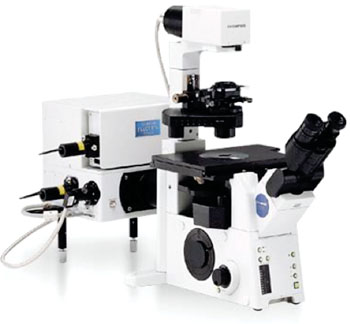Fluorescent Detection System Developed for Identifying Cancer
By LabMedica International staff writers
Posted on 14 May 2014
A new water-soluble fluorescent detection system that is extremely sensitive to pyrophosphate (PPi) has been discovered that might lead to the development of a method for early detection of cancer cells. Posted on 14 May 2014
The highly sensitive probes or sensors that are able to report the PPi level could lead to improved cancer diagnostics, since PPi plays a key role in energy transduction, DNA replication and other metabolic processes that seriously diverge in cancer cells.

Image: The Fluoview 1000 confocal fluorescence microscope (Photo courtesy of Olympus).
Scientists at the University of Jyväskylä (Finland) developed a simple metal complex which shows an intense orange fluorescent color in the presence of very low concentration of pyrophosphate (PPi) in water. The complex, also called a probe, had almost 1,000 times higher level of response than earlier methods and an unprecedented sensitivity to detect PPi at a subnanomolar level with a limit of detection (LOD) of 0.8 nM. The discovery represents the first water-soluble fluorescent sensor that is capable of detecting pyrophosphate at this sensitivity level under physiological conditions.
The investigators were able to show that the probe can image the pyrophosphate in the nuclei of living (HeLa) cells, making it an excellent probe for live cell pyrophosphate imaging. The HeLa cells, originally from Henrietta Lack's cervix carcinoma, are the most long-lived human cancer cell line and are often used as a cancer cell model. In addition to their applicability in water, they can easily be formulated into a hydrogel and coated onto paper strips for low-cost pyrophosphate detection. Fluorescence spectra were obtained on a Varian Cary Eclipse Fluorescence spectrophotometer (Agilent Technologies; Santa Clara, CA, USA) and confocal fluorescence microscopy images were recorded in the Olympus Fluoview 1000 setup (Olympus; Tokyo, Japan).
The authors concluded that a simple terpyridine-Zn(II) complex was efficient and selective in sensing of PPi in water. The ZnCl2L receptor complex showed remarkable fluorescent response, around 500-fold, and an excellent sensitivity toward PPi that allows a subnanomolar level detection. The ZnCl2L was found to form a hydrogel which was subsequently used to make gel coated paper strips for easy, low-cost detection of PPi. They believe these novel findings would be beneficial for the development of commercially viable chemosensory alternatives to enzyme and protein based assays in diagnostics and other clinical applications.
Related Links:
University of Jyväskylä
Agilent Technologies
Olympus














